Hi DiamondBuyingAdvice,
Please help me with choosing a pear cut diamond. I can’t find anything about what an ideal pear cut diamond is supposed to be like. How do I choose the best one?
MM
Hi MM, thanks for sending in your question.
The guidelines for choosing pear cut diamonds share some similarity with other shapes, but there are some which apply uniquely to pear cut diamonds alone.
Let’s go over the terminology first. That way everything can make a little more sense when we go into more detail.
The Anatomy Of A Pear Cut Diamond
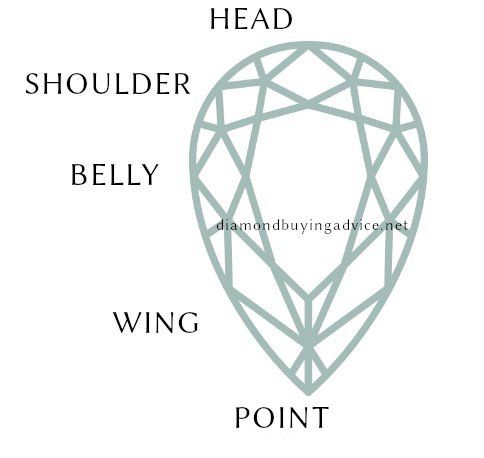
Looking at a pear cut diamond from above we see that we have a round end and a pointy end. The round part shown in the top part of the image is called the head. This is immediately followed by the shoulder. The central part, called the belly, is a part that is measured and is shown on a diamond grading certificate. It’s the second measurement on a diamond’s grading report.
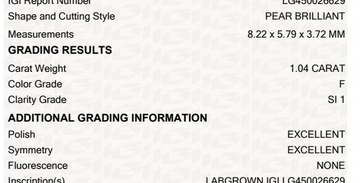
The first measurement is the length from head to tip. The third measurement is the depth of the diamond. To see the diamond’s depth you would have to look at it side on.
The pear shaped diamond, like the round brilliant diamond, is designed in order to provide a high level of sparkle and brilliance. Some of the names of important parts of a faceted gemstone are the same no matter what the cut. So whether it be round brilliant or any other fancy shape such as pear we will still have a:
- Culet: The culet is a small facet at the bottom of the pavilion of a finished gem intended to prevent chipping and abrasion of the fragile tip. Some gems have no facet in this area, which is often called a closed culet.
- Crown: The top part of a gem located above the girdle.
- Girdle: A narrow band that circumscribes the edge of the plane separating the crown and pavilion.
- Pavilion: The portion of a polished gem that is below the girdle. The purpose of pavilion facets is to reflect light toward the crown.
- Table: A large facet in the center of the crown.
Color
Diamond is a very special material. It lets light through but light also bounces off it. And not only does light bounce off of the surface of a diamond but it bounces off the inside of a diamond’s facets. This means light is being returned to the eye of the beholder from the diamond’s surface and from the inside of the diamond. The light being bounced off the inside of a diamond can have the effect of making the actual color level appear less than the color grade it has received.
This effect is clearly demonstrated in any fancy shapes that do not have a 1:1 length to width ratio. Pear cut diamonds are a perfect example of this.
Let’s take a look at a pear cut diamond that has been given a K color grade by GIA.
Like many other fancy shapes such as ovals or marquise cuts, a pear cut diamond tends to show more color than a round brilliant. For this reason I recommend choosing a pear cut diamond that is high on the GIA color scale: D preferably. If you can’t find the size you want in a D color then I would look for an E, and if nothing is available from those two color grades then I would look among the stones with an F color grade.
It is also not uncommon for fancy-color diamond rough to be cut into pear shape.
Symmetry
I’d say one of the most important things to check for is if the diamond shows good symmetry. Look at the diamond face-up and examine its outline. What you want is a pear shaped diamond that has gently rounded shoulders and wings. The wings should form arches that look attractive. If they’re very flat they make the stone look quite narrow. If they’re too rounded they make it look squat and stubby.
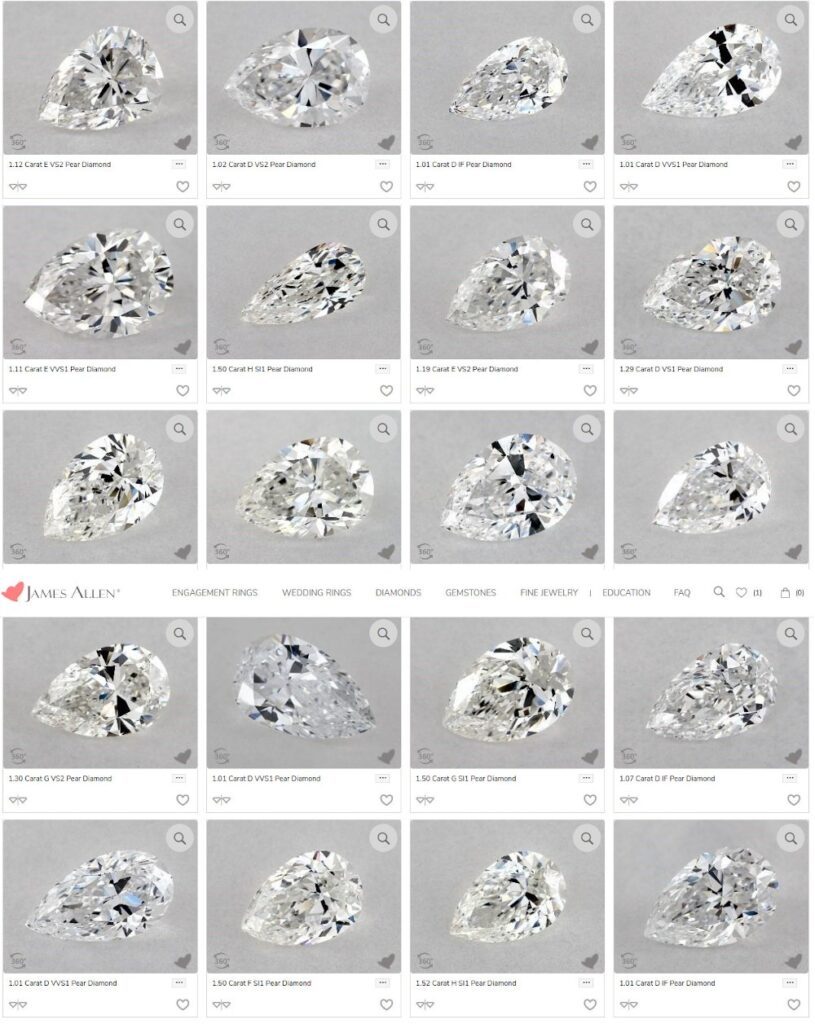
The above image shows a selection of pear cut diamonds. This selection only includes pear cut diamonds that have not received an “Excellent” symmetry grade but rather the lower symmetry grade of “Very Good”.
As you can see there are many different variations from very slim to not so slim at all.
When GIA diamond graders evaluate the symmetry of fancy-shape diamonds, which includes pear shapes, they look for things like a balanced and even outline. Certain types of asymmetry and uneven proportions are considered by most in the jewelry trade to have a negative effect on the appearance of a pear shaped diamond. These include high shoulders, flat wings, bulged wings, undefined points, uneven shoulders and uneven wings. These are all variations that most people find detract from the beauty of a pear shaped diamond.
Length To Width Ratio
The length to width ratio is a comparison of how much longer the length of the diamond is to its width. Many people find they like pear cut diamonds to have a length to width ratio around 1.5:1. The D color pear cut diamond shown in Fig 4 has a length to width ratio of 1.47:1.
Here’s where your preferences will make all the difference. Some people like their pear cut diamond to be as long as 1.8 times its width.
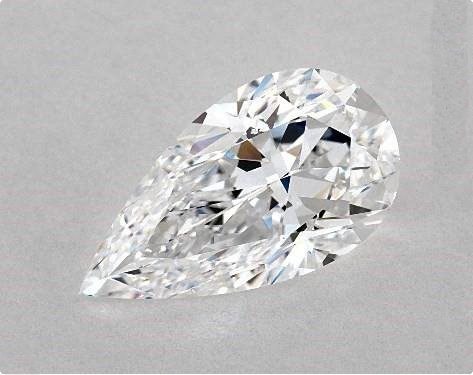
That is really the extreme and most people find something between those two extremes.
I personally think the ratio that has been found aesthetically pleasing to the human eye due to its recurrence in nature, known as the golden ratio, works beautifully for a pear cut diamond, and one that I find to be ideal. But don’t get your hopes up. It’s not always possible to find one with that exact ratio.
Many online jewelers, James Allen included, do not have the length to width ratio as a search parameter so I had to guess which one among the many had measurements closest to the golden ratio. After a few tries I finally hit on one and I hope you’ll agree with me that this one looks absolutely marvelous.
The golden ratio is 1:1.61803 so you can either round up or down to the nearest tenth decimal. The one above I rounded down, but 1.62 will also do. But like I said before the length to width ratio that you like best may be different to mine.
Culet
The location of the culet on a pear shaped diamond is another thing that does affect the look of a pear cut diamond. It’s part of the diamond’s symmetry, so usually this is in the right place if you check the box for excellent symmetry when searching for your ideal pear cut diamond. The culet needs to be nicely centered, that is to say the same distance from the two sides of the diamond. An off-center culet is no good and makes the diamond look asymmetrical which is usually less attractive. In some pear shapes, the culet is included in a keel line that extends down the length of the diamond where the pavilion facets meet. Like the culet, the keel line should be the same distance to both sides of the diamond.
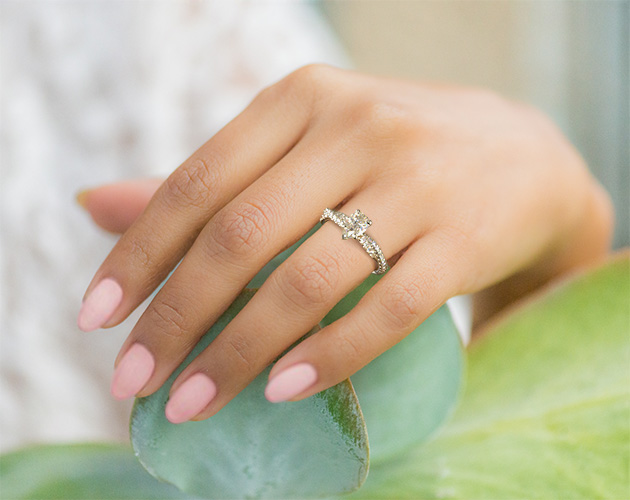
Clarity
If a pear shaped diamond has a larger table facet, inclusions could be more apparent, so clarity should be something you pay close attention to. VS2 may be fine, but don’t take this for granted. VS1 or better are usually where you will find eye-clean pear cut diamonds. Also try to see if the diamond has any inclusions near its point. These inclusions can sometimes be a little hard to see due to the pattern created by the diamond’s facets, so check the plot of inclusions on the diamond’s grading report. Just because the inclusions are hard to see does not mean they don’t affect the diamond. In this case it is the integrity of the diamond that could be at risk. Inclusions in the point may cause weakness in the diamond and be a threat to its durability.
Table
A poorly designed table facet can make a pear shaped diamond look a little wonky. To get the most brightness and fire look for pear cut diamonds whose table is nicely centered. Check the table against the line of symmetry by tracing a line down the middle of the diamond from head to point.
Bow Tie
Some fancy shapes like pears and ovals show a dark pattern that resembles a cute little bow-tie. This “bow-tie” typically runs across the width of the stone from the center of the table. The bow-tie on a well-cut pear shaped diamond should be minimal, but there will still be good contrast between light and dark areas in the stone.
A bow-tie can vary in how dark it looks. It can range from light gray to black. The darker or larger it is, the more it detracts from the face-up appearance of a pear shaped diamond. A bow-tie gets darker as the difference between a diamond’s length and width increases and pavilion angle variations (the measured angle between the pavilion main facet plane and the table plane) become more extreme.
If you find the bow-tie effect annoying just keep looking at more diamonds. Examine a variety of pear shaped diamonds from different angles under the lighting conditions in which the engagement ring will be worn. It’s probably not possible to have zero bow-tie effect but at least you should be able to find one where the bow-tie effect isn’t as pronounced.
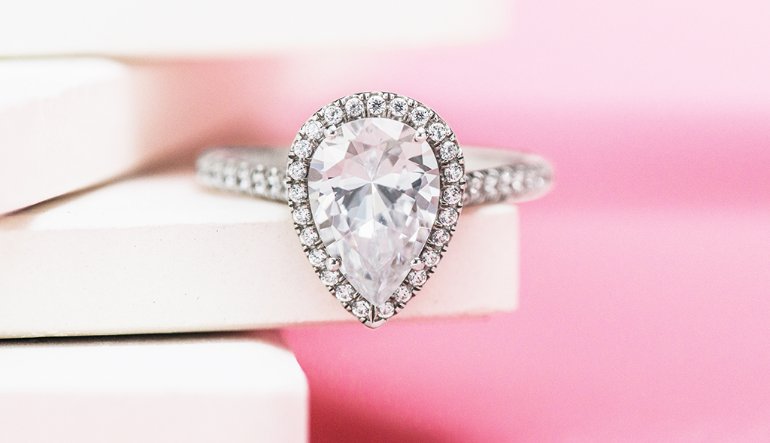
Settings For Pear Cut Diamonds
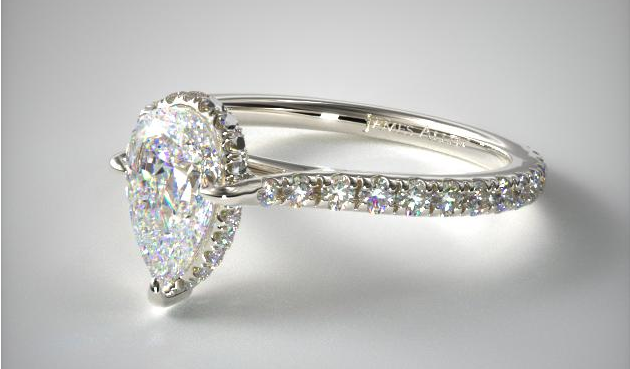
A pear cut diamond’s point is its most vulnerable part. Some people choose settings that have a V prong that protects the point of the diamond.
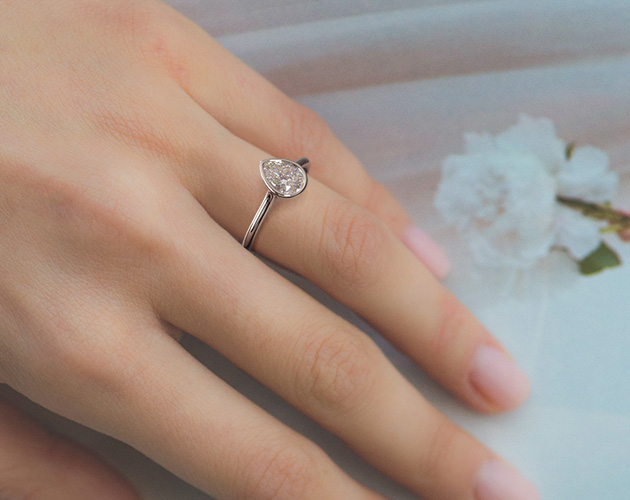
Other people choose a bezel setting which goes all around the girdle. This does restrict a little of the light flow, but some people consider the trade-off worth it to have a more secure stone.
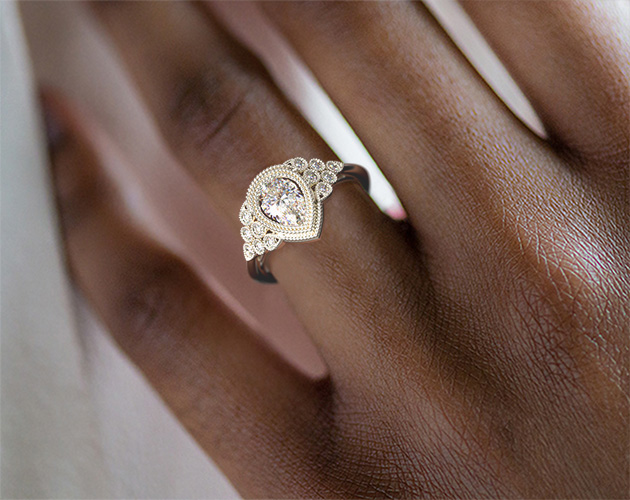
Another option is to have a halo around the central stone.
The Direction
You will find that most pear cut diamonds are worn with the point pointing away, that is to say pointing down when the arm is relaxed by a person’s side. But there is no hard and fast rule for this. And the diamond doesn’t even have to necessarily be set in a north-south orientation. Some people choose to have it set in an east-west orientation.
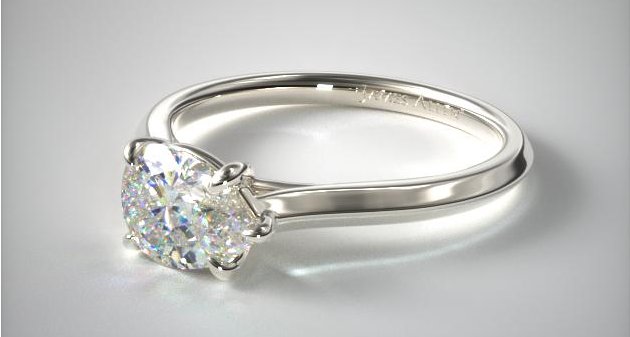
Among the most elegant of the fancy shapes, a pear shaped diamond is one that has both the delicacy of a single tear and the strength of the brightest star. Yes, there are many factors to consider when searching for the perfect stone for your diamond engagement ring, but it is well worth the effort. When deciding between different pear shaped diamonds, the most important factor is how it makes you feel. Does the overall appearance make you feel attracted to it? Sure there are some global rules that can help narrow down a list, but there are also many factors which are purely a matter of taste.
Happy pear picking.
Send in your question
If you are looking to buy any type of diamond jewelry online you are welcome to send in any questions you may have.
As an affiliate of the some of the world’s finest jewelers I am motivated to find the right purchase that is perfect just for you. Every person has specific needs and every jeweler has specific areas in which they excel.
Please use your preferred contact method to get in touch.
Thomas J Stevens GIA DG CSG

If you contact me by email and do not receive a response within 48 hours possible reasons include: my response has ended up in your spam folder; your inbox is full; The best thing after a 48 hour delay is to try again, maybe using a different contact method.

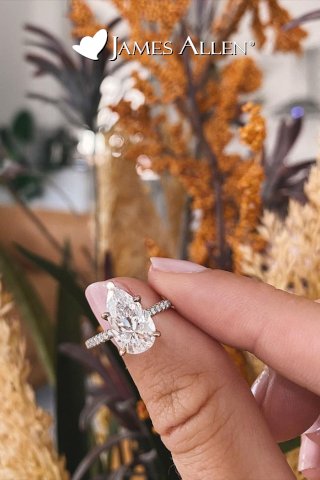
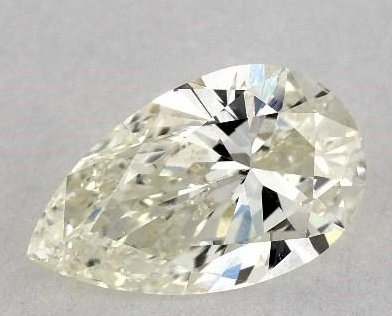
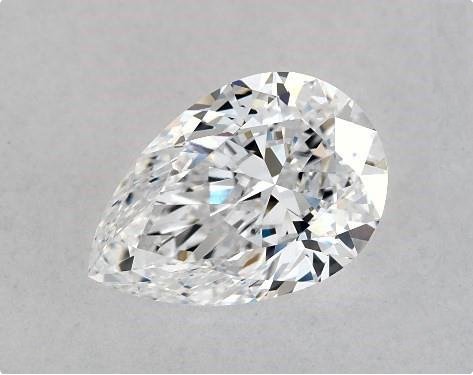
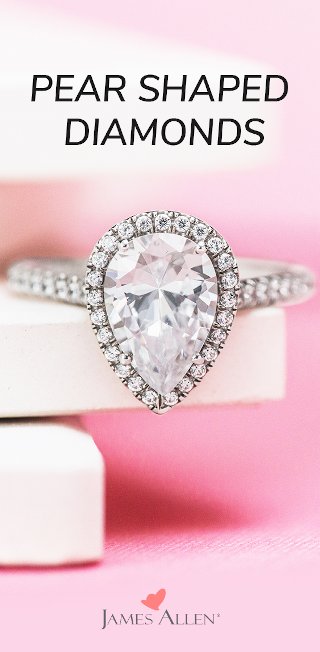
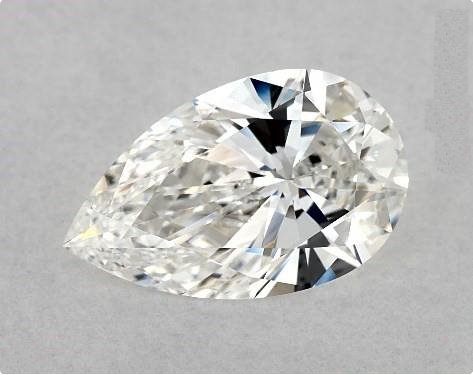
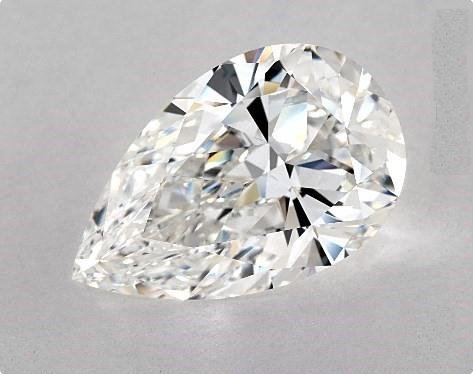
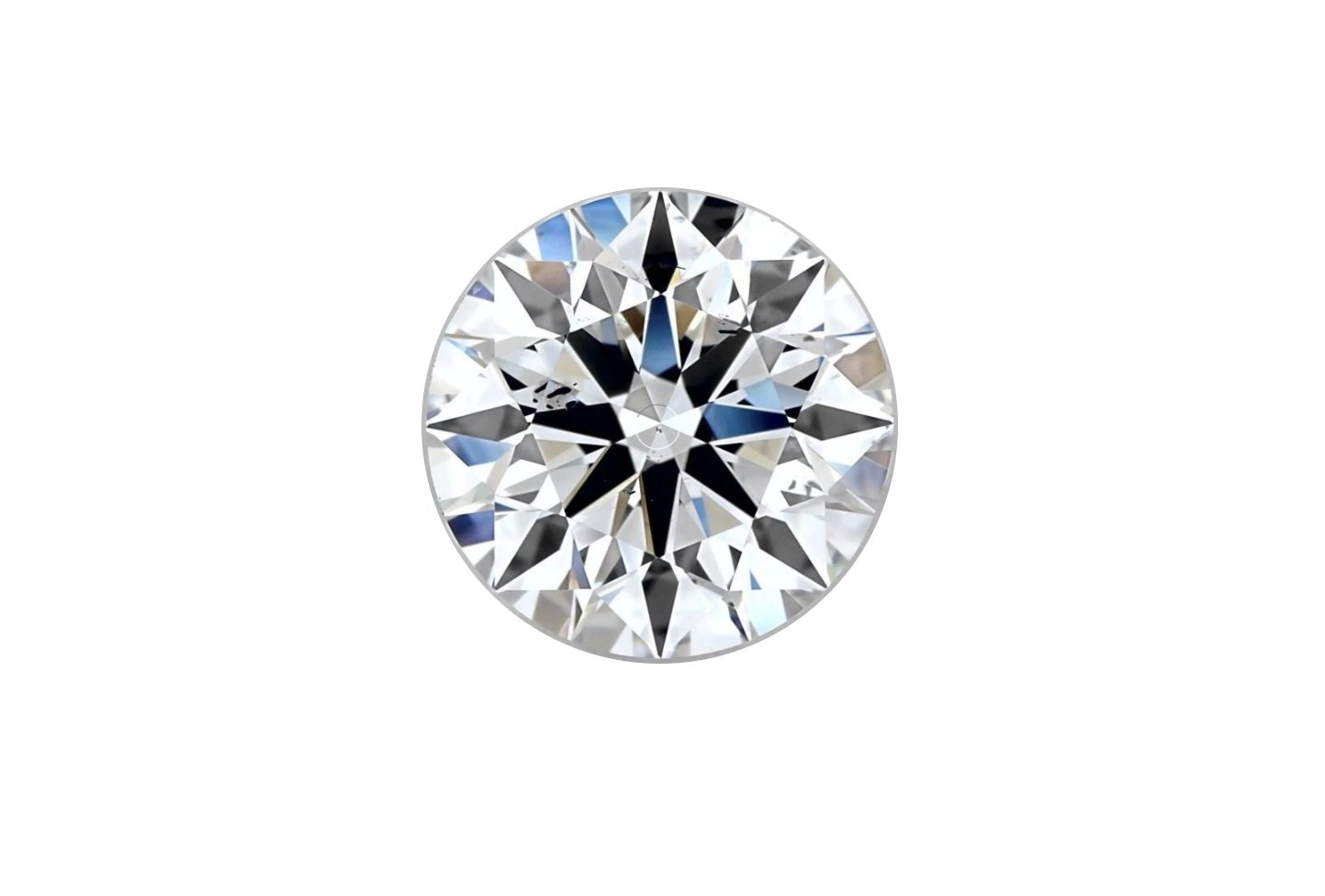
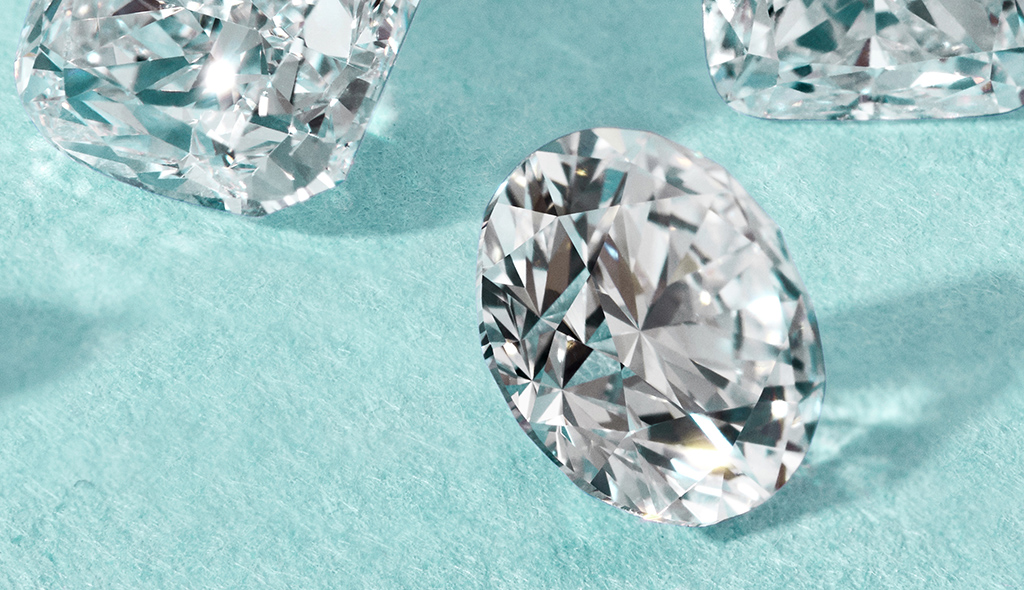
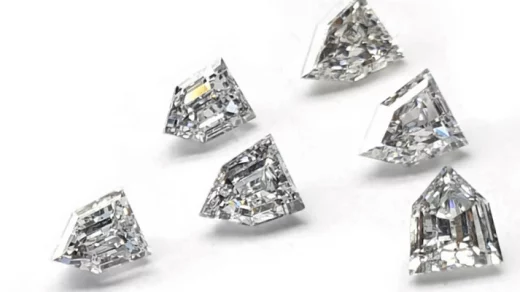
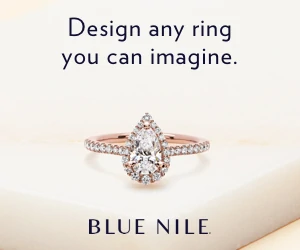
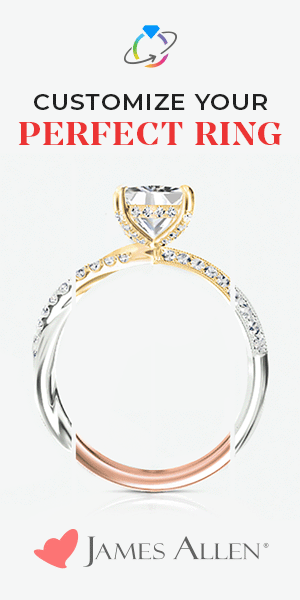
Way cool! Some extremely valid points! I appreciate you writing this article and also the rest of the website is also really good. Celesta Kulseth
Pear cut diamonds look best if they look like a natural drop of water, in my opinion anyway.
I didn’t know this. Thanks.
Can you recommend a pear cut diamond from Ritani? There’s a setting I really like and would love some input from you on choosing a 2 ct diamond.
Check out this one: https://ritani.vxca.net/jWRrJb
what do you think about https://www.jamesallen.com/loose-diamonds/pear-shaped/1.00-carat-d-color-vvs2-clarity-sku-11985245 thanks in advance for your help.
It has a very large crown.
Also the clarity is high which provides little visual benefit.
This one faces up much brighter and is 100% eye clean: https://www.jamesallen.com/loose-diamonds/pear-shaped/1.00-carat-d-color-vs1-clarity-sku-8494413
Things to remember about pears:
the bigger the stone is, the more of a bow tie effect you will see.
the point is not so much of a worry because it is usually protected by a prong.
Length to width is something one should definitely pay attention to. 1.5 length width ratio is very bulbous and round near the end (shorter pear) whereas a 1.65 LW ratio is longer, more teardrop shaped. I would recommend trying on a few to figure out what your preferred ratio is.
color you can def compromise on since you’re setting in yellow metal, as far down as H is prob fine. I compared D though G and the G is slightly more yellow but only in comparison to a whiter stone and compared on the side view of the stones
clarity – VS1 and above is really eye clean, which was hard to tell when I was looking at diamonds online.
the jeweler I worked with let me know that they’re renting/borrowing the stones I saw from whatever network of diamond sellers they had so I didn’t need to pay or anything to view. This might be different for pre-made rings though
I think that’s all I remember off the top of my head. Hope this helps!
Excellent points! thanks for commenting!
My partner is very color sensitive so we only looked at D and E pear diamonds. We got a beautiful 1.2 ct D color pear cut diamond and she couldn’t be happier.
Very happy to hear it! Congrats!
Hi, I am looking for a pear diamond (lab grown) for our engagement ring. Can you direct me to a 1 ct D color pear cut?
Hi Robert, check this one out: https://www.jamesallen.com/loose-diamonds/pear-shaped/1.01-carat-d-color-vs2-clarity-sku-12467130
Anyone who thinks a pear cut diamond will not have a bowtie is dreaming. It’s just about finding one with a bowtie which is not too bad.